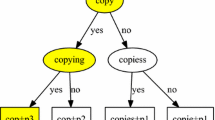Abstract
Language software applications encounter new words, e.g., acronyms, technical terminology, loan words, names or compounds of such words. To add new words to a morphological lexicon, we need to determine their base form and indicate their inflectional paradigm. A base form and a paradigm define a lexeme. In this article, we evaluate a lexicon-based method augmented with data from a corpus or the internet for generating and ranking lexeme suggestions for new words. As an entry generator often produces numerous suggestions, it is important that the best suggestions be among the first few, otherwise it may become more efficient to create the entries by hand. By generating lexeme suggestions with an entry generator and then further generating some key word forms for the lexemes, we can find support for the lexemes in a corpus. Our ranking methods have 56–79% average precision and 78–89% recall among the top 6 candidates, i.e., an F-score of 65–84%, indicating that the first correct entry suggestion is on the average found as the second or third candidate. The corpus-based ranking methods were found to be significant in practice as they save time for the lexicographer by increasing recall with 7–8% among the top candidates.
Access this chapter
Tax calculation will be finalised at checkout
Purchases are for personal use only
Preview
Unable to display preview. Download preview PDF.
Similar content being viewed by others
References
Mikheev, A.: Unsupervised Learning of Word Category Guessing Rules. In: Proc. of the 34th Annual Meeting of the Association for Computational Linguistics (ACL 1996), pp. 327–334 (1996)
Mikheev, A.: Automatic Rule Induction for Unknown-Word Guessing. Computational Linguistics 23(3), 405–423 (1997)
Oflazer, K., Nirenburg, S., McShane, M.: Bootstrapping Morphological Analyzers by Combining Human Elicitation and Machine Learning. Computational Linguistics 27(1), 59–85 (2001)
Wicentowski, R.: Modeling and Learning Multilingual Inflectional Morphology in a Minimally Supervised Framework. PhD Thesis. John Hopkins University, Baltimore, USA (2002)
Goldsmith, J.A.: Morphological Analogy: Only a Beginning (2007), http://hum.uchicago.edu/~jagoldsm/Papers/analogy.pdf
Creutz, M., Hirsimäki, T., Kurimo, M., Puurula, A., Pylkkönen, J., Siivola, V., Varjokallio, M., Arisoy, E., Saraçlar, M., Stolcke, A.: Morph-based speech recognition and modeling of out-of vocabulary words across languages. ACM Transactions on Speech and Language Processing 5(1), article 3 (2007)
Kurimo, M., Creutz, M., Turunen, V.: Overview of Morpho Challenge in CLEF 2007. In: Working Notes of the CLEF 2007 Workshop, pp. 19–21 (2007)
Lindén, K.: A Probabilistic Model for Guessing Base Forms of New Words by Analogy. In: Gelbukh, A. (ed.) CICLing 2008. LNCS, vol. 4919, pp. 106–116. Springer, Heidelberg (2008)
Kuenning, G.: Dictionaries for International Ispell (2007), http://www.lasr.cs.ucla.edu/geoff/ispelldictionaries.html
Lingsoft, Inc.: Demos, http://www.lingsoft.fi/?doc_id=107&lang=en
Lindén, K.: Guessers for Finite-State Transducer Lexicons. In: CICling-2009, 10th International Conference on Intelligent Text Processing and Computational Linguistics, Mexico City, Mexico, March 1- 7 (2009)
Kotimaisten kielten tutkimuskeskuksen nykysuomen sanalista. Research Institute for the Languages of Finland (2007), http://kaino.kotus.fi/sanat/nykysuomi/
Sakarovitch, J.: Éléments de théorie des automates. Vuibert, Paris (2003)
HFST: Helsinki Finite-State Technology (2008), http://www.ling.helsinki.fi/kieliteknologia/tutkimus/hfst/index.shtml
Koskenniemi, K.: Two-Level Morphology: A General Computational Model for Word-Form Recognition and Production. PhD Thesis. Department of General Linguistics, University of Helsinki, Publication No. 11 (1983)
Pirinen, T.: Open Source Morphology for Finnish using Finite-State Methods (in Finnish). Technical Report. Department of Linguistics, University of Helsinki (2008)
Forsberg, M., Hammarström, H., Ranta, A.: Morphological Lexicon Extraction from Raw Text Data. In: Salakoski, T., Ginter, F., Pyysalo, S., Pahikkala, T. (eds.) FinTAL 2006. LNCS (LNAI), vol. 4139, pp. 488–499. Springer, Heidelberg (2006)
Yarowsky, D., Wicentowski, R.: Minimally Supervised Morphological Analysis by Multimodal Alignment. In: Proceedings of the 38th Annual Meeting of the Association for Computational Linguistics (2000)
Lindén, K.: Entry Generation by Analogy—Encoding New Words for Morphological Lexicons. Northern European Journal of Language Technology (May 2009)
Author information
Authors and Affiliations
Editor information
Editors and Affiliations
Rights and permissions
Copyright information
© 2009 Springer-Verlag Berlin Heidelberg
About this paper
Cite this paper
Lindén, K., Tuovila, J. (2009). Corpus-Based Lexeme Ranking for Morphological Guessers. In: Mahlow, C., Piotrowski, M. (eds) State of the Art in Computational Morphology. SFCM 2009. Communications in Computer and Information Science, vol 41. Springer, Berlin, Heidelberg. https://doi.org/10.1007/978-3-642-04131-0_9
Download citation
DOI: https://doi.org/10.1007/978-3-642-04131-0_9
Publisher Name: Springer, Berlin, Heidelberg
Print ISBN: 978-3-642-04130-3
Online ISBN: 978-3-642-04131-0
eBook Packages: Computer ScienceComputer Science (R0)




